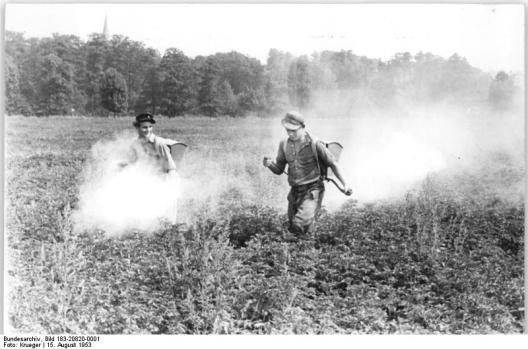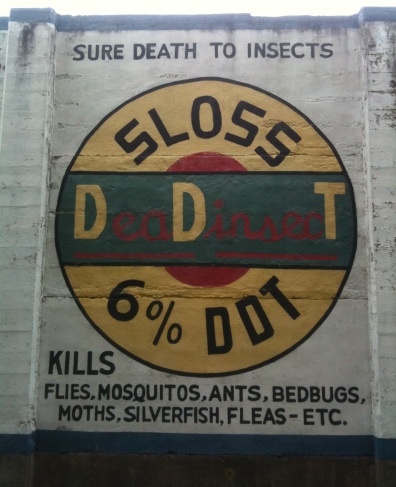We perform many different kinds of experiments in the Center for Sustainable Nanotechnology—some that you might expect (like making new kinds of nanoparticles), and some that you might not (like feeding nanoparticles to tiny organisms such as bacteria and water fleas). The second kind of experiment may seem a little strange to you: why is it important to study how nanoparticles interact with organisms that are so much smaller than we are? While studying what tiny lifeforms do when they encounter new substances might at first seem like a pretty meaningless task; it’s actually really important. Let me tell you a story about a chemical called dichlorodiphenyltrichloroethane, or as it is more commonly known, DDT. DDT was once thought to be harmless, but eventually, people doing work similar to us found out it has the potential to be quite harmful.

How Did We Get Here?
The story of DDT begins with malaria-carrying mosquitoes. Malaria-like illnesses have been a problem for humans since about 2700 BCE.1 It wasn’t until 1897, however, that a British doctor, Sir Ronald Ross, proved that mosquitoes could transmit malaria parasites from person to person. He was awarded the Nobel Prize in Medicine for his discovery in 1902.2 By this time, it was apparent that malaria was a serious human health problem and many people focused their research on decreasing the hold this disease had on so many human populations. For example, malaria was such a serious problem during the construction of the Panama Canal that it contributed to the majority of the 20,000 deaths reported from 1881 to 1894.3
First synthesized by Othmar Zeidler in 1874 for his chemistry doctoral thesis at the University of Strasbourg, DDT was not rediscovered until 1939 by Dr. Paul Müller. Müller was awarded the Nobel Prize for Physiology or Medicine in 1948 “for his discovery of the high efficiency of DDT as a contact poison against several arthropods”.4 His rediscovery of the compound and the subsequent mass use of the chemical to control mosquito populations helped to save thousands of people at the time, and countless more as a result of malaria eradication in many regions. DDT was cheap, easy to synthesize, and long-lasting. In powdered form, it was 4x more effective and much longer-lasting than the favored method of mosquito control at the time.5 Scientists at the time determined that, in the short term, DDT was safe for humans.5-6 However, these initial experiments were done during wartime, and they emphasized understanding short term (or acute) toxicity, rather than the chronic health effects or the ecological impacts of the chemical.5 In addition, the studies were often methodologically flawed and limited in size and scope.5-6
DDT was used widely in the mosquito control effort. To combat mosquitoes in populated areas, people sprayed DDT on the walls and ceilings of houses and public buildings.5, 7 A successful application could remain on those surfaces for 6 months.5 Farmers used DDT to control mosquitoes in agricultural areas by applying it using airplanes and helicopters.5 However, the gains established by using DDT to control mosquito populations had an unknown cost. After a period of time, the long-term effects of DDT began to show. The populations of many animals, birds and fish in particular, began to decrease rapidly. By the 1960s, some biologists began to believe that DDT was the culprit.

DDT at Dangerous Levels? How?
Prior to these studies, few people expected the levels of DDT found in the environment to be harmful to wildlife. So what was happening? Bioaccumulation! Bioaccumulation occurs when a chemical accumulates in a living organism. For a chemical to bioaccumulate, it must remain in the living organism and not be easily broken down by metabolic pathways in that organism. DDT easily becomes embedded into the fat stores of animals where it can remain for many years. For example, in humans, the half-life of DDT is 6.3 years.8 Half-life is the amount of time that it takes for half of the total amount of a compound to degrade.
Bioaccumulation depends on the ease with which a living organism encounters and uptakes a chemical. DDT has a half-life of only a few days in the air, where sunlight breaks it down. In soil, however, it has a half-life of up to 15 years!9 This long half-life gives small organisms a lot of time to take in and accumulate DDT, which can lead to potentially deadly concentrations.
If a larger organism consumes many of these small organisms, the dose (or concentration) of DDT that it experiences becomes larger than it was in the smaller organisms. This process is called biomagnification, and it takes place when organisms higher in the food chain eat many of the smaller organisms that have bioaccumulated the chemical from the environment.

Health & Environmental Consequences
The persistence of DDT in the environment and the bioaccumulation and biomagnification of this compound has led to serious health effects in many organisms. In humans, more recent studies have shown that DDT may be associated with instances of cancer, infertility, miscarriage, and diabetes.6 DDT has perhaps most famously been linked to the population decline of bird species high on the food chain such as the bald eagle and peregrine falcon, via eggshell thinning. Both species rebounded after the US congress put limits on the use of DDT in 1972.16
The widespread and uncontrolled use of DDT had other unforeseen consequences. For example, in Malaysia, the spraying of DDT may have caused the deaths of large numbers of wasps which usually ate moth pests. These moths fed on straw in the thatched roofs of the houses of the people in the region.10 Without wasps to control the moth population, the moths increased in number and collapsed many thatched roofs by eating the straw. Interestingly, the moths were able to distinguish between straw containing DDT and the straw that was DDT-free.10 This ability to avoid DDT-laden straw also contributed to the survival of the moths.10
In another case in Bolivia, a 1965 investigation discovered that spraying of DDT caused the deaths of many cats in a village.11 The CDC in Atlanta confirmed the high concentration of DDT in the cats.11 Without the cats to control the rodent population, there was an outbreak of Bolivian hemorrhagic fever.11 So, in this village, the DDT killed the malaria-carrying mosquitoes, but it also led to the outbreak of another deadly disease!
Brazilian scientists recently completed an interesting analysis of DDT accumulation in chicken eggs in an area located near Rio de Janeiro City in Brazil.7 They researched an area near a house that had last been sprayed with DDT in 1990. They compared DDT in eggs from chickens raised near that house and chickens that were raised in the same locality, but not near the house. The average DDT concentration in the eggs of the chickens raised near the house was 2.7 times greater than in the eggs of the chickens raised in the same locality.7 When they compared this value to the DDT concentrations in eggs purchased in the Rio de Janiero market, the concentration was 1000 times greater! What does this mean for the people living in this area? If a 150 lb person ate the average amount of eggs per day, they would eat 2.54 micrograms of DDT.7 This number approaches the risk value of DDT for chronic toxicity, which is 34 micrograms for a 150 lb person (5 x 10-4 mg/kg for those who want to get more technical).7 The researchers pointed out this only takes into account the DDT coming from eggs. Consumption of meat and milk products might also contribute to a person’s overall DDT exposure.
Now What?
Now we understand that DDT was incredibly useful in the fight against malaria, but it also caused problems in our environment due to bioaccumulation and biomagnification. But what does this have to do with our Center and how we expose nanoparticles to bacteria and water fleas? We carry out these experiments to better understand how the nanoparticles will interact with living organisms in the environment. These experiments are really just the beginning of understanding the effects of nanoparticles when they enter the environment. We haven’t yet begun to study whether nanoparticles bioaccumulate or how they move through the environment, but we are building the foundation necessary to more fully understand these processes.
If scientists had known more about DDT, we could have been proactive about developing better ways to remove it from the environment or create a more benign alternative. As it stands now, many people are working on the issue of environmental removal. Scientists are researching ectomycorrhizal fungi,12 white rot fungi,13 bacteria,14 and many other methods for degradation of DDT already present in the environment.15 If we had mechanisms in place to degrade the DDT before putting it into the environment, or at least understood what was necessary to deal with the persistence of the compound, we could have been better prepared to deal with these issues. That’s the idea behind much of the research in this Center. We wish to better understand the behavior of nanoparticles in the environment to help us figure out this puzzle, before problems arise.
References & Further Reading
1. The History of Malaria, an Ancient Disease.
2. Nobelprize.org Ronald Ross – Biographical.
3. Harvard.edu Tropical Diseases and the Construction of the Panama Canal, 1904-1914.
4. NobelPrize.org The Nobel Prize in Physiology or Medicine.
5. Kinkela, D., DDT and the American Century. The University of North Carolina Press: Chapel Hill, NC, 2011.
6. DDT and human health, in Science of The Total Environment
7. DDT environmental persistence from its use in a vector control program: a case study.
8. Wolff, M. S., Letter to the Editor. Archives of Environmental Contamination and Toxicology 1999, 36, 504.
9. NPIC DDT Fact Sheet.
10. Deterioration of thatch roofs by moth larvae after house spraying in the course of a malaria eradication programme in North Borneo.
11. Parachuting Cats and Crushed Eggs: The Controversy Over the Use of DDT to Control Malaria.
12. Degradation and mineralization of DDT by the ectomycorrhizal fungi, Xerocomus chrysenteron.
13. Co-remediation of DDT-contaminated soil using white rot fungi and laccase extract from white rot fungi.
14. Desulfomonile tiedjei gen. nov. and sp. nov., a novel and anaerobic, dehalogenating, sulfate-reducing bacterium.
15. DDT remediation in contaminated soils: a review of recent studies.
16. Can the Bald Eagle Still Soar After It Is Delisted?
Note: This post was edited on Sept 29, 2015 to update the bioaccumulation/biomagnification figure.

[…] Para leer el blog original en ingles, presione aquí. […]
[…] Bioaccumulation and Biomagnification (Photo: Sustainable Nano) […]
[…] an industrialized society, we already deal everyday with the consequences of man-made chemical contamination in our environment. These contaminants may be too subtle to easily see (BPA leaching into your personal water bottle, […]
[…] degrade. When they do not degrade they can start to accumulate and concentrate in living organisms (see Laura Olenick’s post). Additionally, phosphate-containing soaps may be one (of several) causes of the eutrophication […]
Great article!